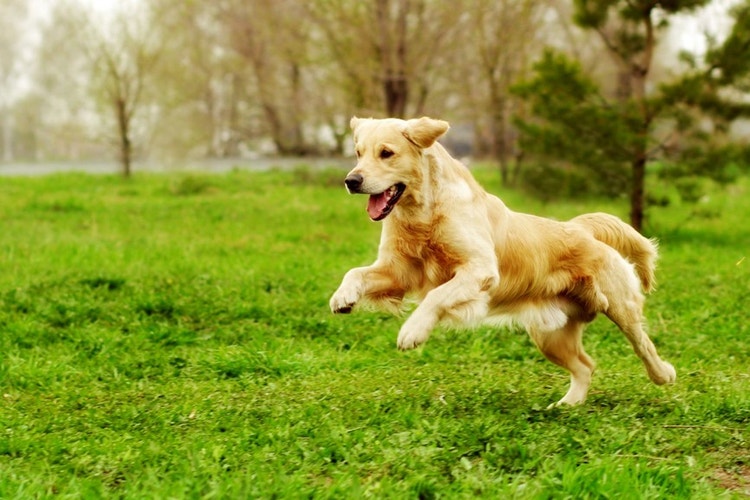
Golden Retriever Breed Traits and Personality


Where Are Golden Retrievers From?
The Golden Retriever dates back to the early 1800s, when they developed a reputation as a premier hunting dog in Scotland. It is said that in 1865, Lord Tweedmouth made a plan to breed the ideal gun dog on his Scottish estate. He initially bred a yellow Wavy-coated Retriever with a Tweed Water Spaniel, taking the best bitch from the litter and first crossing her with a Red Setter and then with a Tweed Water Spaniel.
Offspring from both litters were bred back to the Wavy-coated Retriever, followed by mating of the golden-colored pups to produce the foundation of the Golden Retriever. The breed was originally called the Flat-coated Retriever, then renamed Golden in 1903, before ultimately being dubbed the Golden Retriever in 1911. Golden Retrievers were introduced in America at the end of the 19th Century, but were not registered into the American Kennel Club until 1932.
Caring for a Golden Retriever
What Kind of Diet Does a Golden Retriever Need?
What Kind of Diet Does a Golden Retriever Need?
The Golden Retriever requires a high-quality diet, which is essential for their health and well-being. Proper nutrition may also help prevent food-related skin allergies. Obesity is a concern, so sufficient exercise is required to maintain a healthy weight. Only offering occasional treats helps, too.
How Often Do You Need to Brush a Golden Retriever?
How Often Do You Need to Brush a Golden Retriever?
Regular daily brushing is recommended to prevent matting. Brushing can prevent excess shedding and keep the coat healthy. You’ll need to take your Golden to a professional groomer to remove large mats, should they develop.
Are Golden Retrievers Healthy?
Are Golden Retrievers Healthy?
Due to the popularity of the Golden Retriever, poor breeding practices have been implemented to keep up with demand, which has resulted in health issues. Diseases like certain cancers, hip dysplasia, allergies, and epilepsy are some of the most common among the breed. Their lifespan averages 10 – 12 years.
Golden Retrievers are predisposed to: gastric torsion, hip dysplasia, epilepsy, hot spots, hypothyroidism, atopy, interdigital dermatitis, food allergy, lick granuloma, cataracts, diabetes, osteocondrosis of the shoulder, corneal ulceration, glaucoma, laryngeal paralysis, entropion, ectropion, distichiasis, melanoma, mast cell tumors, hemangiosarcoma, progressive retinal atrophy, aortic stenosis, pericardial effusion, ectopic ureter, elbow dysplasia, dwarfism, osteochondrosis, and Von Willebrand’s disease.
Are Golden Retrievers Easy to Train?
Are Golden Retrievers Easy to Train?
The Golden Retriever is an extremely intelligent and highly adaptable breed. They have been trained to do a multitude of tasks, including acting as a companion animal, drug and seizure detection, and search and rescue work.
How Much Exercise Does a Golden Retriever Need?
How Much Exercise Does a Golden Retriever Need?
Golden Retrievers require a fair amount of exercise, but are still capable of being docile napping partners. They do well in almost any lifestyle setting and, if well-exercised, can be playful, robust companions. The Golden is always happiest when with family, no matter what they are doing!

Are You Ready to Adopt a Golden Retriever?
To adopt a Golden Retriever puppy, start by making sure this type of dog will fit your lifestyle. Use our pet adoption checklist to walk through each step in the adoption process. Complete the necessary adoption applications and be prepared for interviews or home visits. Spend time with potential dogs to find a good match. Finally, prepare your home for the new pet, ensuring it's safe and welcoming.

Pet Insurance Options for Golden Retrievers
Pet insurance for a Golden Retriever may help cover costs for conditions like cancer and allergies. Consider a policy that includes hereditary and congenital conditions, flexible coverage options, and reasonable premiums.
Use our insurance aggregator tool to compare providers and find the best plan for your dog's unique needs.
What Are the Physical Characteristics of a Golden Retriever?
Golden Retriever Facts
Other Breeds to Explore
References
- Morris, Desmond. Dogs: The Ultimate Dictionary of Over 1,000 Dog Breeds. Trafalgar Square, 2002.
- American Kennel Club. The Complete Dog Book. Random House Digital, Inc., 2006.
- Wilcox, Bonnie and Chris Walkowicz. The Atlas of Dog Breeds of the World. T.F.H Publications, Inc., 1995.
- Greenberg, Aurora. “Golden Retriever Dog Breed Information.” American Kennel Club, 6 Nov. 2017, www.akc.org/dog-breeds/golden-retriever/.


